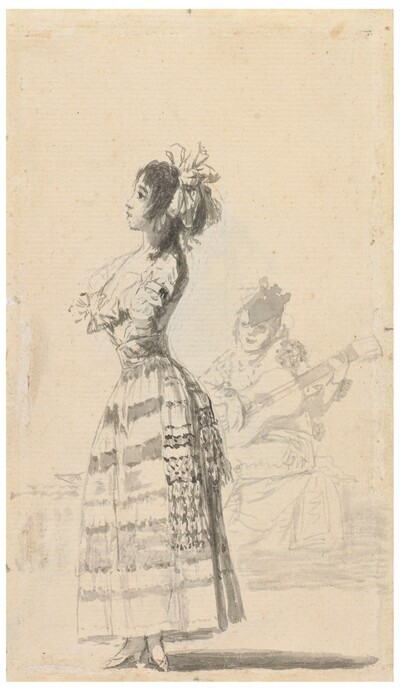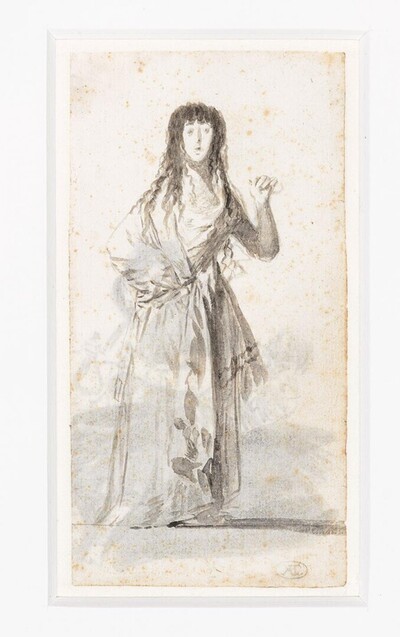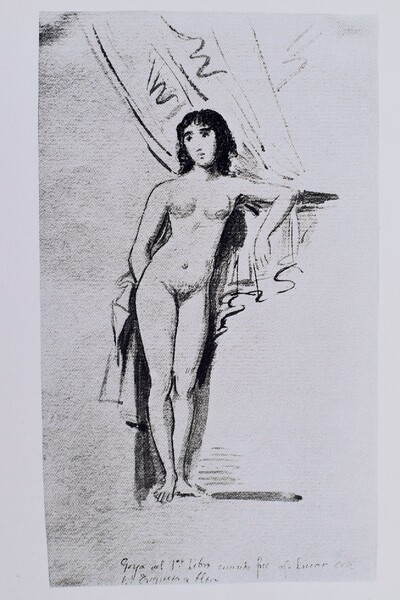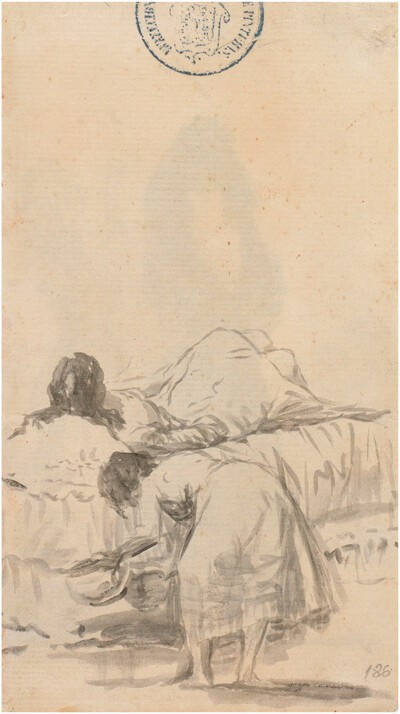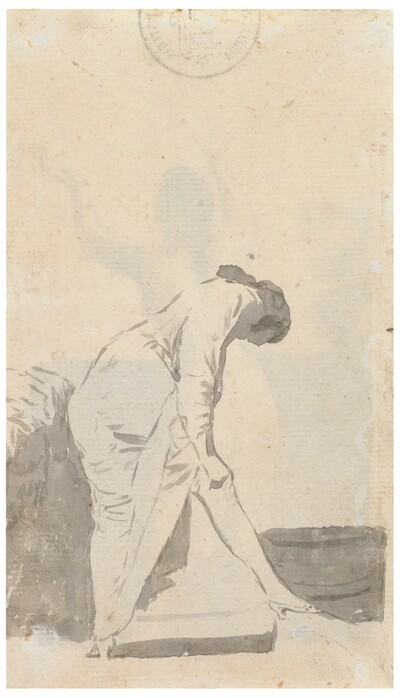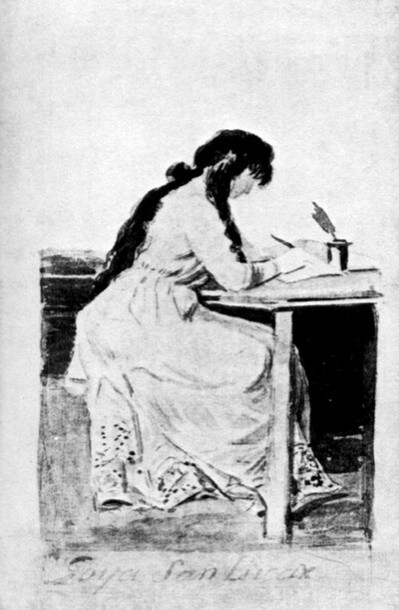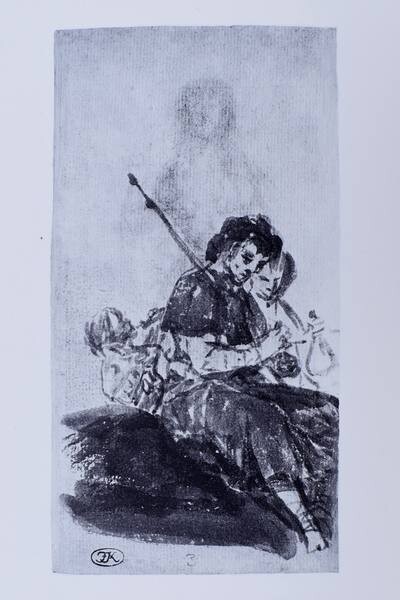- Cronología
- Ca. 1794 - 1795
- Ubicación
- Biblioteca Nacional, Madrid, España, Madrid, Spain
- Dimensiones
- 190 x 97 mm
- Técnica y soporte
- Aguada de tinta china sobre papel
- Reconocimiento de la autoría de Goya
- Documented work
- Titular
- National Library of Spain
- Ficha: realización/revisión
- 08 Mar 2011 / 29 Jun 2023
- Inventario
- (DIB/15/8/37/1)
- Otros títulos:
-
Joven de frente tocada con un sombrero pequeño
La duquesa de Alba
Retrato de mujer
COLECCION DEL Sº. Dº. V. CARDERERA / ADQUIRIDA POR EL GOBIERNO EN 1867 (wet seal, lower right-hand corner)
This drawing is conventionally presented as the first in Notebook A or Album A, also known as the Sanlúcar Album because, according to Vicente Carderera (1860), it was a notebook that Goya began during a journey in the company of the famous Duchess of Alba, Doña María Teresa de Silva, when the noble lady left for Andalusia... and settled for a time in her stately villa of San Lúcar de Barrameda.
It is not easy to pinpoint the reasons for Goya's trip to Andalusia and, in particular, to this town in Cádiz, although we have several pieces of information that allow us to give some chronological details of when it took place:
In February 1796 José Álvarez de Toledo, 13th Duke of Alba, travelled from Madrid to Andalusia to attend to the affairs of his estates. Towards the end of May the Duke fell seriously ill in Seville. On learning of his illness, his wife, the Duchess Mª Teresa Cayetana de Silva, left Madrid and was still able to attend to him in his last days. He died on 9 June 1796. A few days later the widowed Duchess retired to her possessions in Sanlúcar de Barrameda (Cádiz), where she remained until 1799. At the same time, there are several reports of Goya's stay in Andalusia, the duration and reasons for which have not been sufficiently clarified. It seems that in June 1796 he was in Seville and then in Sanlúcar, as evidenced by the testimony of the sculptor Joaquín Arali when, in a letter of 22 July sent to the scholar Juan Agustín Ceán Bermúdez, he asked him to give Goya his memoirs, if he was there [in Seville] on his way back from San Lúcar. At the end of December and beginning of January 1797 Goya remained in Andalusia. At that time he was suffering from an illness in Cadiz and received visits from the writer Nicolás Fernández de Moratín and the merchant Sebastián Martínez. Goya is first recorded as having returned to Madrid on 1 April 1797, when he resigned from the San Fernando Academy of Fine Arts because of ill health.
Carderera's commentary and the other facts expressed, as well as the informal air that emanates from Notebook A, consolidated the historiographical tradition that his drawings were born in the quiet atmosphere of the small court and servants who accompanied the Duchess of Alba to her possessions in Sanlúcar in the summer of 1796. More extreme interpretations came to consider these drawings as one of the testimonies to the romance that, according to legend, Goya had had with her.
The documentary contributions and the review of the whole matter by Mena and Mühle-Maurer have led, however, to consider a different context and chronology for the Notebook A, which could date back to 1794 (or even 1793), well before Goya's trip to Andalusia, his second since his previous stay in 1793. Goya was in the service of the Duke and Duchess of Alba from at least August 1794, when it is recorded that he had already been commissioned to paint the portrait of The Duchess of Alba in White, which he painted in 1795, as well as the two small paintings depicting the Duchess's domestic surroundings entitled The Duchess of Alba and the Beata and The Beata and the children María de Luz and Luisito Berganza. These were surroundings in which Goya may have had the opportunity to take notes about the Duchess herself, as drawings A.a, A.f and A.q suggest. As for other drawings in the album depicting young women in casual poses, far from being girls from Cádiz or representing the Duchess's servants in Sanlúcar, as has been repeatedly written, they may plausibly have been inspired by taverns or brothels in Madrid. On the other hand, Notebook A shows an undoubted continuity with the first block of drawings in Notebook B, the origin of which is also thought to date from the same chronological period.
In the same way, it is now thought that the creative process of The Caprices may have begun in 1794, earlier than is usually supposed, some of whose engravings offer clear correspondences with drawings from the notebooks (especially A.j, A.n and A.p.) and B.
After Goya's death, Notebook A passed to his son Javier (1828) and to his grandson Mariano (1854). It was then dismembered and the separate sheets began to be dispersed. Some were in the possession of Valentín Carderera in 1860.
At the present time only eight sheets of the safe notebook are known, worked on both sides, giving a total of sixteen drawings (A.a-A.p). They lack original numbering, so it is impossible to establish their correlation. There is also a sheet with two other drawings that could be copies by Carderera (A.q-A.r) and three more drawings that are known exclusively as copies (A, copies a, b and c).
Drawing A.a, the first of those catalogued, belonged to Carderera and in 1867 passed to the National Library of Spain.
The drawings in Notebook A all depict young women depicted in a variety of carefree poses, in most cases scantily clad or completely nude. Goya delights in a feminine universe of curves and sensual contours in which the female body is perceived under petticoats or fully exposed while being bathed by the sun. The endless variety of the female being is shown by Goya in insinuating, pensive, tender, etc. scenes. Although there are elements of elegant mockery and delicate humour in these drawings, there is no sign of the severe and critical moralising attitude that he would later develop in other drawings and engravings.
They seem to reflect the relaxed atmosphere that Goya breathed during his stay in Sanlúcar. They do not depict monuments, landscapes or popular scenes, only women; not even a couple. As Sayre indicates, they are a hymn to women.
There is a recurring face in several of his female figures: an almond-shaped face with a small mouth, large eyes, narrow nose and strong, expressive eyebrows which, according to Carderera, represented the Duchess of Alba herself. She and her servant girls inspired Goya in a dreamlike atmosphere, free of worries and obligations. Apart from the speculations that some authors have made about a possible idyll between Goya and the Duchess, there is no doubt that the trip to Sanlúcar meant for him a rebirth of his art under the sign of the woman.
The notebook used by Goya was bound in the direction of its height. It was made of Dutch paper, slightly bluish in tone, laid and with an A.m. watermark. He used for the first time the technique of Indian ink wash applied directly with a brush, without any underlying pencil strokes or any other kind. Although he was clumsy due to his inexperience, it was to prove a very free and revolutionary technique which he continued to practise often afterwards. He first drew a light brushstroke with pale ink to situate the subject and specify the main lines. Then he applied broader brushstrokes to arrange the shadows. Finally, he finished the drawing with touches of dark, almost black gouache to accentuate the details. Occasionally, exceptionally, he used some pen or graphite strokes.
The first of the drawings shows a female figure, standing frontally, with her head tilted slightly to the left. She wears a small hat on her head and a rich dress with a frill and a scarf over her shoulders. The background is indeterminate and only a few shadows can be made out. Traditionally, this figure has been associated with the Duchess of Alba, but not all authors share this opinion. In the lower part, a piece of paper has been added on which the woman's feet are drawn in black pencil and Indian ink, possibly by Carderera, imitating those of Goya's majas, but in an unlikely position.
On the reverse is a Young Woman Lifting Her Skirt
-
Exposición de dibujos de 1750 a 1850Sociedad Española de Amigos del ArteMadrid1922from May to June 1922cat. 190D
-
Grabados y dibujos de Goya en la Biblioteca NacionalBiblioteca NacionalMadrid1946catalogue Elena Páez Ríoscat.155
-
cat.150
-
Goya and his timesThe Royal Academy of ArtsLondon1963cat. 66cat. 159
-
Goya: zeichnungen, radierungen, lithographienInternational TageIngelheim1966exhibition displayed from May 7th to June 5 th 1966cat. 1
-
Goya en la Biblioteca Nacional. Exposición de grabados y dibujos en el sesquicentenario de su muerteBiblioteca NacionalMadrid1978May - June 1978cat. 153
-
Goya. Das Zeitalter der Revolucionen. Kunst um 1800 (1980 – 1981)Hamburger KunsthalleHamburg1980cat. 222a
-
Goya: Zeichnungen und DruckgraphikStädtische Galerie im Städelschen KunstintitutFrankfurt1981from February 13th to April 5th 1981cat. L3
-
Ydioma universal: Goya en la Biblioteca NacionalBiblioteca NacionalMadrid1996from September 19th to December 15th 1996cat. 111a
-
Francisco de Goya: Maleri, Tegning, GrafikkNasjonalgallerietOslo1996from 10th to April 14th 1996cat. 31
-
Reason and Folly: The Prints of Francisco GoyaNationall Gallery of VictoriaMelbourne1998fig. 16
-
Madrid2019cat. 191
-
Goya, sa vie, son œuvreParísHenri Plon1867pp.215-227
-
La Duquesa de Alba y Goya. Estudio biográfico y artísticoMadridBlass1928
-
Goya’s Caprichos. Beauty, Reason and CaricatureNueva JerseyPrinceton University Press1953vol. II fig. 1
-
Eight Books of Drawings by GoyaThe Burlington MagazineLondon1964pp. 24-25, cat.a
-
Vie et ouvre de Francisco de GoyaParísOffice du livre1970p. 171, cat. 356
-
Dibujos de Goya: Los álbumesBarcelonaNoguer1973p. 41, cat. A.a [1]
-
Ydioma universal: Goya en la Biblioteca NacionalMadridBiblioteca Nacional, Sociedad Estatal Goya 96 y Lunwerg1996cat. 111a
-
La duquesa de Alba, «musa» de Goya. El mito y la historiaMadridEdiciones el Viso, Museo Nacional del Prado2006pp. 127-147
-
MadridMuseo Nacional del Prado2019pp. 286-287

